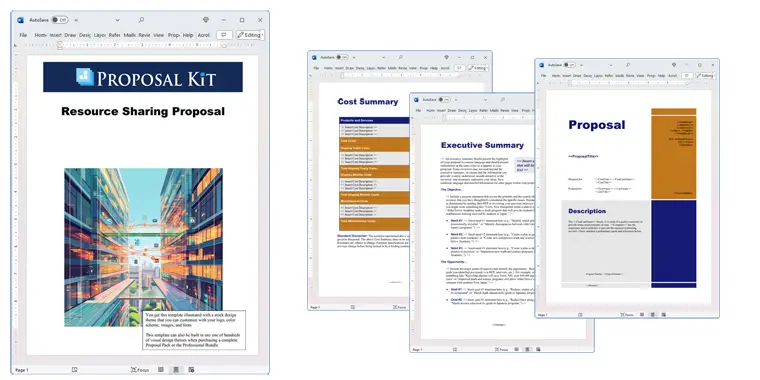How to write your Resource Sharing Proposal
We include this 26 page layout with every Proposal Pack. If you want this template to have a different visual design theme than the one illustrated here, purchase any Proposal Pack design and create this template using the purchased design theme. This template is included in every Proposal Pack. If you get a Proposal Pack or the Professional, you can also make any variation of this template with different chapters to suit your needs.
We typically include more chapters in the templates than most people will need to give everyone more variety in the chapters they may need. You can trim down a long template by removing pages you do not need or combining multiple chapter topics into one page.
 DOWNLOADABLE, ONE-TIME COST, NO SUBSCRIPTION FEES
DOWNLOADABLE, ONE-TIME COST, NO SUBSCRIPTION FEESYou can also create countless variations of this document to suit your needs using the included library of 2200+ chapters if ordering a Proposal Pack or Professional.
 What Our Clients Say
What Our Clients SayI purchased the original version of this product back in 2013 when I started my consulting business. the product is great. I love that I don’t have to start any given proposal from scratch- regardless of the type of service I’m providing or the industry. I recommend this product to anyone who has to write any types of proposals for business."
Erestar Inc.
Related Article
Related Video
Related Templates
- Job Share Position Proposal
- Joint Venture Proposal
- Health Food Bar Partnership with Gym Proposal
- Fashion Designer Strategic Partnership Proposal
- Spa and Beauty Salon Partnership Proposal
- Luxury Spa and Hotel Joint Venture Proposal
- Merger of Companies Proposal
- Stockpiling Emergency Supplies Proposal
What's the Best Way to Write Your Resource Sharing Proposal?
The Proposal Kit template library and Wizard software package are proven solutions for writing a resource Proposal. This comprehensive system guides you through the proposal writing process. It incorporates a robust line item quoting database for cost summaries, quotes, estimates, budgets, and other financial details, making it an invaluable tool for creating a resource cooperation proposal.
Do you need to write a proposal and search for a solution? The Proposal Kit is designed for you.
What Types of Projects Are Resource Sharing Proposal Written For?
Resource coordination projects are implemented in many situations where entities aim to optimize their resources by working together. These projects often require detailed proposals to outline the terms and benefits of shared resources. Here are some examples of the types of projects that such proposals are written for:
- Coordinated disaster relief efforts between government agencies
- Joint resource pooling between hospitals
- Shared supply chains between retail companies
- Resource optimization among educational institutions
- Collaborative infrastructure development between cities
- Regional emergency response coordination
- Shared inventory management among manufacturers
- Joint research initiatives between universities
- Cross-border resource distribution agreements
- Inter-agency fuel stockpiling
- Collaborative water resource management
- Shared agricultural resource initiatives
- Joint software development between tech firms
- Cross-company logistics plans for perishable goods
- Regional tourism development coordination
- Shared telecommunications infrastructure projects
- Collaborative environmental conservation projects
- Joint energy resource development
- Infrastructure sharing between transportation agencies
- Resource sharing in community healthcare initiatives
Chapters this template is built with
Every proposal for sharing resources is unique, and no one-size-fits-all template covers every situation. However, the Proposal Kit software allows you to create custom variations to address all situations. Here are some key chapters from the extensive content library of thousands of templates that you can customize for your proposal:
Cover Letter
The cover letter sets the stage by introducing the purpose and key topics of the resource collaboration proposal to the potential partner. It should establish a connection with the recipient, briefly summarize the proposal's main objective, and highlight the mutual benefits of entering into a resource-sharing agreement. A well-written cover letter can make a solid first impression and motivate the recipient to read further.
Executive Summary
This chapter provides a concise overview of the proposal, highlighting the main objectives and anticipated benefits of resource sharing. It should summarize the key points of the proposal, such as the financial savings, operational improvements, and advantages of the collaboration, making it easier for decision-makers to grasp the proposal's value quickly.
Cost Summary
The cost summary details the financial topics involved in the resource coordination project, ensuring transparency. This chapter should include projected costs, potential savings, and a comparison of current versus proposed expenses. It is crucial to demonstrate the financial viability and attractiveness of the resource-sharing initiative.
Needs Assessment
This chapter outlines the specific needs that led to the proposal and helps the reader understand the necessity for resource sharing. It should identify the gaps or inefficiencies in the current resource management system and explain how the proposed sharing arrangement will address these issues, thus establishing a strong rationale for the collaboration.
Goals and Objectives
Clearly state the goals and objectives you wish to achieve through the resource coordination proposal, ensuring alignment between entities. This section should detail what success looks like for both parties and how the shared resources will contribute to achieving these outcomes, fostering a sense of shared purpose and commitment.
Benefits
This chapter focuses on the advantages both parties will gain through the resource-sharing initiative. It should articulate specific benefits such as cost reduction, enhanced service delivery, risk mitigation, and alignment, helping to build a case for why both entities should engage in the partnership.
Operational Impact
Discuss how the proposed resource sharing will impact each entity's existing operations. This includes changes to processes, workflows, and roles that may arise due to the collaboration. A thorough analysis will help both parties understand the necessary adjustments and prepare for operational transitions.
Emergency Response Plan
This section outlines how shared resources will be managed in emergencies, ensuring readiness and resilience. The plan should address how resources will be allocated during crises, who will be responsible for decision-making, and what protocols will be in place to ensure swift and efficient responses.
Transportation
Detail the logistics of transporting shared resources and addressing potential challenges or requirements. This includes identifying transportation modes, scheduling, and coordination efforts necessary to move resources between entities, ensuring that logistics do not become a bottleneck in the sharing process.
Warehousing
Explain how shared resources will be stored, including considerations for capacity, security, and accessibility. This section should cover storage solutions that accommodate the volume and nature of the resources, ensuring they are kept safe and can be accessed easily when needed.
Resource Allocation
Describe the process for allocating resources between entities, ensuring clarity and fairness. It should outline criteria for prioritizing resource distribution, methods for tracking allocations, and mechanisms for resolving disputes, thereby fostering trust and cooperation.
Resource Management
Discuss the management strategies that will be in place to oversee the shared resources and maintain efficiency. This includes assigning responsibilities, implementing monitoring systems, and developing protocols for inventory control, all of which are important for optimal resource utilization.
Replenishment
Outline the procedures for replenishing shared resources to prevent shortages and ensure continuity. The proposal should specify how and when resources will be replenished, who will manage stock levels, and what processes will be in place to forecast and address future needs.
Transfers
Explain the logistics of transferring resources between entities, including legal or logistical considerations. It should detail the steps involved in resource handovers, any documentation required, and measures to ensure smooth and dispute-free transfers.
Safety Net
Detail the contingency plans that will be in place to mitigate risks and protect the collaboration. This chapter should outline strategies for dealing with potential disruptions, ensuring both entities have a backup plan to maintain operations and safeguard shared resources.
Stockpiles
Describe how stockpiles of resources will be managed, including rotation and consumption rates. The proposal should address how stockpiles will be monitored, how they will be rotated to prevent obsolescence, and how consumption will be tracked to ensure sustainability.
Entities Affected
Identify the entities impacted by the resource-sharing plan, ensuring all stakeholders are considered. This section should list all parties involved or affected by the proposal, detailing their roles, responsibilities, and engagement in the process.
Utilization
Discuss how the shared resources will maximize benefits and minimize waste. This includes identifying optimal use cases, setting usage guidelines, and implementing measures to track and report resource utilization, ensuring that resources are used efficiently.
Cost/Benefit Analysis
Provide a detailed analysis of costs versus benefits to help justify the resource coordination proposal. This should include a comparison of direct and indirect costs versus anticipated benefits, offering a clear picture of the proposal's economic impact and value proposition.
Project Summary
Summarize the project, reinforcing the key points and the importance of the resource-sharing initiative. This chapter should reiterate the proposal's main objectives, benefits, and operational details, serving as a final persuasive topic to encourage stakeholder buy-in.
Facilities
Discuss the facilities required to support resource sharing, including any modifications or upgrades needed. This section should address infrastructure requirements, potential sites for shared facilities, and any investments necessary to accommodate the shared resources.
Distribution
Outline the distribution plan for shared resources, ensuring they reach the intended recipients efficiently. It should include details on distribution channels, schedules, and coordination efforts to ensure timely and effective delivery of resources.
Personnel
This chapter should detail the personnel involved in managing and executing the resource sharing plan, highlighting their roles and responsibilities. It should also specify the team structure, key roles, and any training or support needed to ensure the successful implementation of the resource-sharing initiative.
Use cases for this template
Maximizing Disaster Response Efficiency
The Challenge
Jenna, the logistics manager at CityPrep Relief, was in crisis mode when back-to-back natural disasters hit her region. The aftermath revealed a glaring issue: the uneven distribution of stockpiled resources between her organization and neighboring relief agencies. This disparity caused significant inefficiencies and delays in their collective response efforts, hampering their ability to aid those in need. Jenna realized that their response capabilities would be protected with a coordinated approach to resource allocation and distribution.
The Solution
Determined to improve the situation, Jenna took the initiative to write a proposal to coordinate resource stockpiling and distribution efforts with nearby agencies. She turned to Proposal Kit, a trusted tool for creating well-structured proposals, to help her formulate a plan that detailed how shared resources could be efficiently pooled and allocated during emergencies. Using the Proposal Kit, she created a comprehensive and professional document highlighting the benefits of collaboration and resource sharing.
The Implementation
Jenna assembled the proposal using Proposal Kit's extensive template library, focusing on key areas such as cost summaries, emergency response plans, and transportation logistics. The templates provided a solid framework, allowing her to present a case for cooperation. Jenna's proposal outlined a detailed plan that ensured resources could be mobilized swiftly to the areas most in need, minimizing delays and maximizing the effectiveness of their response.
The Outcome
The proposal was promptly accepted by all parties involved. This acceptance began a new era of collaboration between CityPrep Relief and its neighboring agencies. As a result, operational efficiency improved dramatically, and response times during emergencies became significantly faster. Jenna's leadership and the successful implementation of her proposal positioned CityPrep Relief and its partners as leaders in disaster preparedness and response coordination.
Enhancing Academic Resource Networks
The Challenge
At ScholarConnect, a nonprofit educational hub dedicated to fostering academic collaboration, Liam faced a challenge. Tasked with enhancing the resource exchange between affiliated schools, he was under pressure to meet tight deadlines with little guidance on producing an impactful proposal. The existing system of resource sharing needed to be more cohesive, leading to inefficiencies and missed opportunities for academic growth and support.
The Solution
Seeking a solution, Liam turned to Proposal Kit, which offered customizable templates ideally suited for creating a proposal to lay the foundation for a shared academic resource network. Recognizing the potential of AI writing tools, he also integrated this technology into his process to refine the content further. By analyzing ScholarConnect's website and other materials, the AI tool helped generate detailed descriptions and enhance the proposal's narrative, ensuring clarity and coherence.
The Implementation
Using the Proposal Kit, Liam quickly developed a coherent and comprehensive proposal. The templates guided him in articulating the logistics of resource sharing and the anticipated academic benefits of the proposed network. The AI tool provided additional insights, making the proposal more persuasive and aligned with ScholarConnect's vision. This synergy between technology and human input resulted in a well-rounded document ready for presentation to stakeholders.
The Outcome
The proposal received unanimous approval from ScholarConnect's partners, paving the way for establishing a network that facilitated seamless sharing of educational materials. This initiative significantly reduced costs and broadened schools' access to resources across the network. The successful implementation of the proposal enhanced resource utilization and fostered an environment of collaboration and shared academic excellence.
Revolutionizing Healthcare Resource Distribution
The Challenge
Olivia, a director at HealthUnity, a nonprofit committed to improving healthcare access, was confronted with a challenging task. Her organization needed to write a Request for Proposal (RFP) for companies capable of supplying a coordinated healthcare resource distribution system across regions plagued by supply shortages. The stakes were high, and Olivia knew that a poorly created RFP could result in continued inefficiencies and compromised healthcare delivery.
The Solution
Turning to the Proposal Kit, Olivia created a detailed RFP that would attract potential vendors with the capacity to manage a large-scale healthcare resource-sharing system. The templates provided by Proposal Kit ensured that no topic of the supply chain was overlooked, covering everything from distribution logistics to warehousing needs. This comprehensive approach allowed Olivia to define the project's requirements and expectations clearly.
The Implementation
With Proposal Kit's customizable templates, Olivia tailored the RFP to include specific distribution, warehousing, and emergency stockpiling criteria. The document was created, leaving no room for ambiguity. Once finalized, the RFP was distributed to various vendors, sparking interest and generating competitive responses from qualified candidates eager to contribute to the solution.
The Outcome
The thoroughness and clarity of Olivia's RFP paid off, leading to the selection of a vendor that provided an efficient and effective resource-sharing system. This new system significantly improved healthcare delivery and response times in the regions served, ensuring that shortages were addressed swiftly and proactively. HealthUnity's reputation as a healthcare facilitator was solidified, and Olivia's leadership was instrumental in driving this transformative change through her use of the Proposal Kit.
Conclusions and Recommendations
Creating a winning proposal for resource coordination requires attention to detail, clear objectives, and a sound understanding of the financial implications. Using Proposal Kit's comprehensive template library and software simplifies this process and ensures that all critical topics are included. From cover letters to detailed cost summaries, Proposal Kit provides a tailored approach to proposal writing, enabling individuals and organizations to present compelling cases for resource collaboration. Whether you face tight deadlines or complex logistical challenges, Proposal Kit is your key to creating impactful resource partnership proposals.
Also Known As
This template may also be referred to in different ways or be used in more specialized situations, such as:
- Resource Coordination Proposal
- Resource Partnership Proposal
- Shared Resource Proposal
- Collaborative Resource Plan
- Joint Resource Initiative
- Resource Pooling Proposal
- Resource Optimization Plan
- Resource Distribution Proposal
- Resource Management Proposal
- Resource Utilization Proposal
Abstract
 Resource-sharing proposals are integral to optimizing resource use across various sectors, from healthcare to education and scientific research. These proposals aim to enhance the allocation, management, and sharing of resources such as data, laboratory equipment, and software. By coordinating these assets, entities can achieve significant cost reductions, operational efficiencies, and improved outcomes.
Resource-sharing proposals are integral to optimizing resource use across various sectors, from healthcare to education and scientific research. These proposals aim to enhance the allocation, management, and sharing of resources such as data, laboratory equipment, and software. By coordinating these assets, entities can achieve significant cost reductions, operational efficiencies, and improved outcomes.
Key topics in developing such proposals include robust data management strategies, the use of research tools like model organisms and genomic data, and clear guidelines on material transfer agreements and software sharing. The scientific community, often reliant on NIH-sponsored research, benefits immensely from such sharing, as it facilitates collaboration and accelerates research findings. Proposals typically cover topics like cost summaries, emergency response plans, and operational impacts, ensuring a comprehensive approach to resource management.
The Proposal Kit offers a comprehensive solution for creating detailed resource-sharing proposals. Its features include extensive content libraries of customizable templates, automated line-item quoting, and complex document assembly, making it easy for researchers to articulate their specific plans for resource collaboration. Whether dealing with new model organisms or DNA libraries, the Proposal Kit ensures that proposals are well-structured and tailor-fit to address the unique needs of each initiative. By fostering a cooperative environment through defined goals, objectives, and benefits, these proposals enable entities to respond to specific funding opportunities, aligning with NIH guidelines and responding to needs in a structured manner.
 Resource-sharing proposals play an important role in fostering innovation and collaboration across various fields by facilitating the management and sharing of unique research resources. These resources, which include model organisms, cell lines, and DNA libraries, are vital for proposed research that can lead to groundbreaking discoveries. By sharing scientific data and employing tools like cloning tools and growth factors, researchers can enhance their studies with diverse models, including animal models. Such sharing is especially important for NIH-sponsored research, where the effective distribution of resources can lead to more efficient and impactful research outcomes.
Resource-sharing proposals play an important role in fostering innovation and collaboration across various fields by facilitating the management and sharing of unique research resources. These resources, which include model organisms, cell lines, and DNA libraries, are vital for proposed research that can lead to groundbreaking discoveries. By sharing scientific data and employing tools like cloning tools and growth factors, researchers can enhance their studies with diverse models, including animal models. Such sharing is especially important for NIH-sponsored research, where the effective distribution of resources can lead to more efficient and impactful research outcomes.
The Proposal Kit is instrumental in creating proposals that highlight these opportunities. Its extensive content library enables users to tailor proposals to specific situations, such as securing a PHS fellowship supplemental form or addressing a specific funding opportunity. This adaptability ensures that all topics of resource management, including data management and sharing, are comprehensively covered. By simplifying the proposal writing process, Proposal Kit allows researchers to focus on their core scientific goals, ensuring that their work aligns with NIH guidelines and responds to restricted requirements.
Moreover, these proposals help bridge gaps in resource distribution, offering a structured framework for collaboration. They are invaluable for researchers looking to maximize the utility of combinatorial chemistry techniques or for institutions seeking to optimize their resource allocation. As a result, the scientific community can achieve a higher level of cooperation, leading to accelerated research progress and the development of innovative solutions. Through well-written proposals, entities can navigate the complexities of sharing resources, ultimately advancing scientific knowledge and driving positive change.
 The development and sharing of unique research resources are in advancing scientific endeavors. These resources, such as newly developed model organisms and extensive DNA libraries, serve as foundational topics for a variety of scientific studies. The sharing of these model organisms not only drives collaboration but also enhances the reproducibility and validation of research findings. Within the field of NIH-sponsored research, these shared resources are instrumental in fostering a network of cooperation that bolsters the scientific community's endeavors to push the boundaries of knowledge.
The development and sharing of unique research resources are in advancing scientific endeavors. These resources, such as newly developed model organisms and extensive DNA libraries, serve as foundational topics for a variety of scientific studies. The sharing of these model organisms not only drives collaboration but also enhances the reproducibility and validation of research findings. Within the field of NIH-sponsored research, these shared resources are instrumental in fostering a network of cooperation that bolsters the scientific community's endeavors to push the boundaries of knowledge.
Proposal Kit aids in the meticulous creation of resource-sharing proposals by providing structured templates that address complex requirements like the PHS fellowship supplemental form. This ensures that proposals are not only comprehensive but also aligned with NIH's stringent guidelines, thus maximizing the potential for securing funding and facilitating groundbreaking research. By streamlining the proposal process, Proposal Kit enables researchers to focus on the intellectual and practical topics of their work, ensuring that the unique research resources developed are used to advance scientific inquiry.
In addition, these proposals lay the groundwork for sustainable and resource sharing, which is critical in a scientific landscape. As researchers navigate the complexities of their work, the ability to access and use shared resources efficiently becomes a cornerstone for success. By promoting the management and sharing of these invaluable assets, resource-sharing proposals contribute significantly to the acceleration of innovation, offering pathways to new discoveries and enhanced scientific understanding. Through this collaborative framework, the scientific community can better address global challenges, paving the way for a future of shared success and discovery.
Frequently Asked Questions
What is the main objective of a proposal for sharing resources?
The main objective of a proposal for sharing resources is to present a structured plan that facilitates the efficient and effective sharing of resources between two or more entities. This document outlines how the involved parties will coordinate their efforts to optimize resource use, reduce costs, and enhance operational efficiencies. The proposal aims to create a framework that supports sustainable and equitable resource distribution by clearly defining the terms of collaboration, responsibilities, and mutual benefits.
How detailed should the financial components of a proposal for sharing resources be?
The financial components of a proposal for sharing resources should be detailed enough to provide a clear understanding of the monetary implications for all parties involved. This includes creating a thorough cost summary, which breaks down expenses, potential savings, and the overall project budget. It's crucial to present a cost/benefit analysis that demonstrates the financial advantages of the proposed resource-sharing agreement, making a case for its implementation.
What common mistakes should be avoided when writing a proposal for sharing resources?
When writing a proposal for sharing resources, common mistakes include failing to clearly define each entity's roles and responsibilities, overlooking the importance of a solid needs assessment, and neglecting to address potential risks and mitigation strategies. It's important to ensure the proposal is well-organized and comprehensive, with each section logically leading to the next. Avoid ambiguous language and ensure all parties understand the objectives and expectations clearly.
How can I ensure my resource-sharing proposal is persuasive and effective?
To ensure your resource-sharing proposal is persuasive and effective, clearly communicate the collaboration's benefits and potential impact. Use an executive summary to highlight key points and engage stakeholders from the start. Incorporate real data and evidence to support your claims and provide a detailed plan for implementation, including timelines and measurable goals. Tailor the proposal to the specific needs and concerns of the entities involved, showing how the resource-sharing arrangement aligns with their objectives.
What templates or tools can assist in creating a comprehensive resource-sharing proposal?
Templates and tools like those offered by Proposal Kit can significantly enhance the process of creating a comprehensive resource-sharing proposal. These resources provide structured templates for each proposal section, from the cover letter to the project summary, ensuring you include all necessary components. Proposal Kit offers customization options, allowing you to tailor the proposal to fit the specific requirements and context of your project while also incorporating a line item quoting database for accurate financial calculations.
20% Off Discount
![]() Add To Cart This Word Template
Add To Cart This Word Template
 Add To Cart Proposal Pack for Any Business
Add To Cart Proposal Pack for Any Business
 Add To Cart Proposal Kit Professional
Add To Cart Proposal Kit Professional
 4.7 stars, based on 849 reviews
4.7 stars, based on 849 reviewsProposal Kit chapters used in this template
Cover Letter, Title Page, Table of Contents, Executive Summary, Needs Assessment, Goals and Objectives, Operational Impact, Entities Affected, Benefits, Safety Net, Stockpiles, Transfers, Warehousing, Transportation, Distribution, Resource Allocation, Resource Management, Utilization, Replenishment, Emergency Response Plan, Facilities, Personnel, Cost Summary, Cost/Benefit Analysis, Project Summary, Back Page
Line Item Automated Chapters
If you purchase a Proposal Pack or the Professional Bundle, these proposal pages are generated using an automated line-item database in the included Wizard software.
Cost Summary, Cost Benefit Analysis
You use this proposal for
- General business proposal
- Non-technical proposal
- Internal company proposal
- Business opportunity, partnership proposal
How to create this template with Proposal Pack Wizard
You can create this document using any of the logo-designed Proposal Packs. Pick any Proposal Pack with a logo design theme you like best; they will all work equally well. The Proposal Pack for Any Business is the pack with no extra added logos or colors - designed to be used plain or for you to customize with your logos and graphics.
The Proposal Pack design theme you purchase will determine the visual look of this template. The screenshot above only shows the plain generic design theme.
We include a library of chapters to be assembled based on your needs. All proposals are different and have different needs and goals. We designed Proposal Pack so you can customize the documents to suit your needs.
You will best create this document using the Proposal Pack Wizard - Expert Edition software to select this template and build it in the Proposal Pack logo design theme of your choice along with any desired customizations (such as adding additional chapters, removing unneeded chapters, changing the order of chapters, and importing your company logo). This template outlines a proposal for the described situation. Each user is responsible for typing in the actual content of the provided pages with their information to complete the proposal. Suggestions in the abstract may include features in higher-end packages and are facilitated by the selection of chapter templates to support the narrative of each proposal, which help guide the user in filling in the details.
The Wizard software's AI Writer will write the content of the pages of the template based on details provided for your company, client, project, financial details and other writing instructions. This will provide a personalized version of the template completely written and ready to edit.
Once finished, the AI Writer's Word-to-PowerPoint converter can transform your proposal, business plan, or other business documents into a PowerPoint slideshow. Save time and effort by letting the AI analyze every chapter to condense its content into talking points, visually matching the document, and providing a consistent package of presentation material with the click of a button.
You create this template using the Wizard software with an entire Proposal Pack library and software. We include the Expert Edition of the software in the Proposal Kit Professional. Microsoft Word for Windows is required to use the customizing software. You can also edit Word document templates in other office software such as Word for Mac. We will assist Mac users in assembling complex templates for their first project if they do not have the required platform to run the Wizard software.
How to Build Templates Featured on Proposal Kit Website
Many people find the Proposal Kit website after searching for a specific proposal. Once you've purchased and installed the software, how do you build that template you found in the first place? This video shows you how to build any proposal you see on the Proposal Kit website.
 Ian Lauder has been helping businesses write their proposals and contracts for two decades. Ian is the owner and founder of Proposal Kit, one of the original sources of business proposal and contract software products started in 1997.
Ian Lauder has been helping businesses write their proposals and contracts for two decades. Ian is the owner and founder of Proposal Kit, one of the original sources of business proposal and contract software products started in 1997.By Ian Lauder
 Published by Proposal Kit, Inc.
Published by Proposal Kit, Inc.


 Cart
Cart
 Get 20% off ordering today:
Get 20% off ordering today: 


 Facebook
Facebook YouTube
YouTube Bluesky
Bluesky Search Site
Search Site